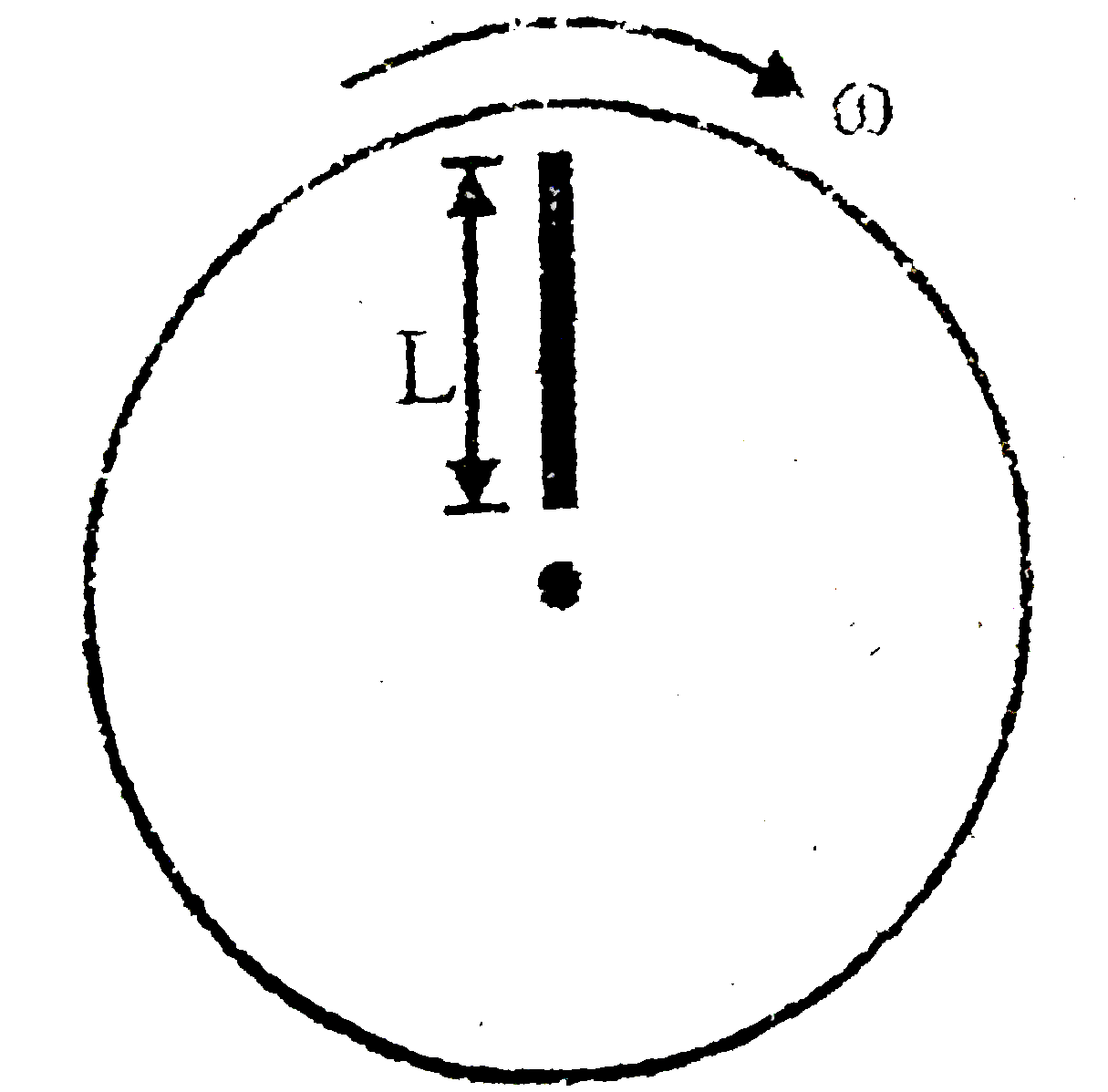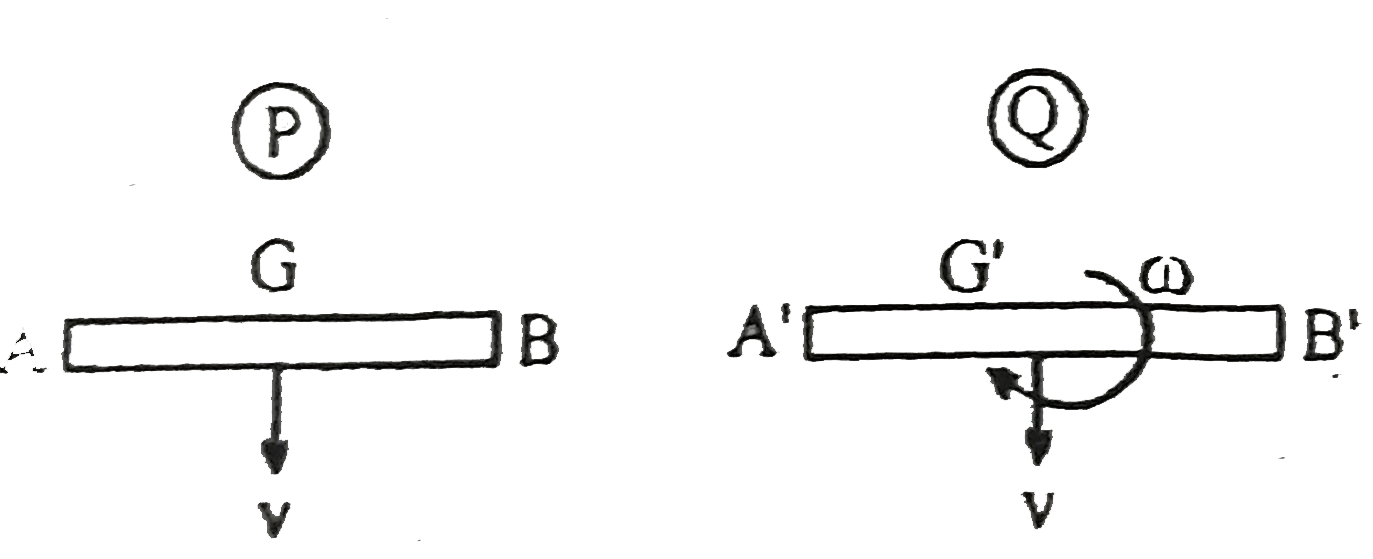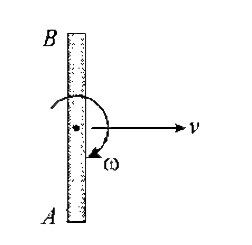Two identical thin rods are moving on a smooth table, as shown. Both of them are rotating with angular speed ω, in clockwise sense about their centres. Their centres have velocity V in opposite directions. The rods collide at their edge and stick together. Length of each rod is L.
(a) For what value of VωL there will be no motion after collision ?
(b) If the ratio VωL is half the value found in (a) above, what fraction of kinetic energy is lost in the collision?

The correct Answer is:(a) 16
(b) 4952
Topper's Solved these Questions
Similar Questions
A uniform rod of mass m and length L lies radialy on a disc rotating with angular speed ω in a horizontal plane about vertical axis passing thorugh centre of disc. The rod does not slip on the disc and the centre of the rod is at a distance 2L from the centre of the disc. them the kinetic energy of the rod is

View SolutionA uniform rod of length l is spinning with an angular velocity ω=2vl while its centre of mass moves with a velocity v. Find the velocity of the end of the rod.

View Solution
Knowledge Check
Two equal uniform rods P and Q move with the same velocity v as shown in the figure. The second rod has an angular velocity ω(<6v/l) (clockwise) about G in addition to v.
 AIf the ends A and A' are suddenly fixed simultaneously both rods will rotate with the same angular velocityBIf the ends A and A' are suddenly fixed simultaneously the rod Q will rotate with greater angular velocityCIf the ends B and B' are suddenly fixed simultaneously both rods will rotate with the same angular velocityDIf the ends B and B' are suddenly fixed simultaneously, the rod P will rotate with greater angular velocity
AIf the ends A and A' are suddenly fixed simultaneously both rods will rotate with the same angular velocityBIf the ends A and A' are suddenly fixed simultaneously the rod Q will rotate with greater angular velocityCIf the ends B and B' are suddenly fixed simultaneously both rods will rotate with the same angular velocityDIf the ends B and B' are suddenly fixed simultaneously, the rod P will rotate with greater angular velocityA uniform rod of mass m and length L lies radialy on a disc rotating with angular speed ω in a horizontal plane about vertical axis passing thorugh centre of disc. The rod does not slip on the disc and the centre of the rod is at a distance 2L from the centre of the disc. them the kinetic energy of the rod is
 A49mL2ω224B2mω2L2C124mω2L2D13mL2ω224
A49mL2ω224B2mω2L2C124mω2L2D13mL2ω224A uniform rod AB of length l rotating with an angular velocity ω while its centre moves with a linear velocity v=ωl6 If the end A of the rod is suddenly fixed, the angular velocity of
 A34ωBω3Cω2D23ω
A34ωBω3Cω2D23ω
A uniform rod of length l is spinning with an angular velocity ω=2vl while its centre of mass moves with a velocity v. Find the velocity of the end of the rod.

View SolutionA copper rod of length L rotates with an angular with an angular speed 'ω' in a uniform magnetic field B. find the emf developed between the two ends of the rod. The field in perpendicular to the motion of the rod.
View SolutionA uniform rod of mass M and length a lies on a smooth horizontal plane. A particle of mass m moving at a speed v perpendicular to the length of the rod strikes it at a distance a4 from the centre and stops after the collision. Find a. the velocity of the cente of the rod and b. the angular velocity of the rod abut its centre just after the collision.
View SolutionA uniform rod of mass M and length a lies on a smooth horizontal plane. A particle of mass m moving at a speed v perpendicular to the length of the rod strikes it at a distance a4 from the centre and stops after the collision. Find a. the velocity of the cente of the rod and b. the angular velocity of the rod abut its centre just after the collision.
View SolutionA copper rod of length L rotates with an angular with an angular speed 'ω' in a uniform magnetic field B. find the emf developed between the two ends of the rod. The field in perpendicular to the motion of the rod.
View Solution
